Too Many Books: Are There Too Many Comics Being Published Today?
“There aren’t enough comics,” said Warren Ellis at the open of his third Come in Alone column at Comic Book Resources in 1999.
Ellis assumed at the time that most people would think he’d gone mad, but he insisted he was being truthful. As proof, he leaned on “Sturgeon’s Law”, a theory posited by sci-fi writer Theodore Sturgeon that claimed 90% of everything – TV, movies, books, breakfast tacos, etc. – is more or less garbage. Depending on your perspective that’s both damning about media and accurate. But Ellis’s view, as per usual, was atypical.
If 90% of comics are bad, then 10% of them are good. How do we get more good comics?
By making more of them.
Makes sense, doesn’t it? Don’t worry; we’re not the only one in agreement with old Uncle Warren. In the almost 16 years since Ellis wrote that article, comic publishers have taken care of things.
While there is little historical data on the subject—the total release numbers Diamond Comic Distributors provides only goes back to July of 2013—if you asked most readers, retailers, publishers, creators and industry pundits, they’d agree: we’re at a pinnacle in terms of total titles being released, at least for the modern era. And it feels like it’s getting to be bigger and bigger.
Whether it’s a litany of books being revealed at the latest con, Image taking over Twitter with a deluge of titles announced at Image Expo, or even greater numbers of comics slipping through the cracks because so many others are being announced, it often seems what’s next is a wave that never seems to crest.
Years back, you’d see comments on websites or social media popping up from time to time, facetiously lamenting the volume of comics that were being announced. Lines like “I love it but my wallet doesn’t” were commonplace, and it was all in good fun. Who doesn’t want more comics, especially ones as promising as the titles we were seeing?
Then, as the new continued to arrive and the old stuck around, the temperature changed. A vocal part of the readership grumbled louder than ever, often wondering if we reached the other end of the spectrum of Ellis’s brave new world. Are there too many comics now?
It’s a fair question, and one we’re going to attempt to answer today, both from a quantitative and qualitative standpoint.
Are There More Comics Than Ever?
Before we dig into the information about the sales and quality of comics, it is worthwhile to do what we can to figure out if we’re at a high point as an industry in terms of releases or if it just feels like that. While complete historical data isn’t there, there is enough we can mine to come up with something that answers our question.
Let’s start with the most recent data: May 2015. That month, there were 436 total new comics and 228 new trades and graphic novels released, totaling 664 releases from Diamond. That is a lot. But is it the most? Not by a long shot.
According to John Jackson Miller—the man behind Comichron, one of the comic industry’s most valuable resources and the basis for much of the information I’ve developed for today’s piece—2015 has nothing on 1993. In those halcyon days that featured the rise of both Image and Valiant, Miller shared the comic industry was “looking at 600 comics a month coming out in 1993”, topping out in November. Miller shared that the Capital City sales charts—Capital City was a predecessor to Diamond in terms of distribution—featured 737 new comic releases in November alone, topping the comics and graphic novels total from March with its comic total alone. Is it any surprise this period of excess almost led to the demise of the industry?
When you count trades and graphic novels—which are more popular now than ever—that’s when things tip towards the modern era.
“If you’re looking at simple number of releases — comic and trade paperback, not counting digital — that’s probably higher than it’s ever been,” Miller said.
Just look at October of 2014 if you’d like proof. In October, there were a staggering total of 964 new releases. That’s almost 1,000 comics, trades and graphic novels being released for retailers to order in a one month span. I pity the person deciding what comics to order.
While the data we have is limited, what we have supports the idea that we’re at a high, and one continuing to trend upwards.
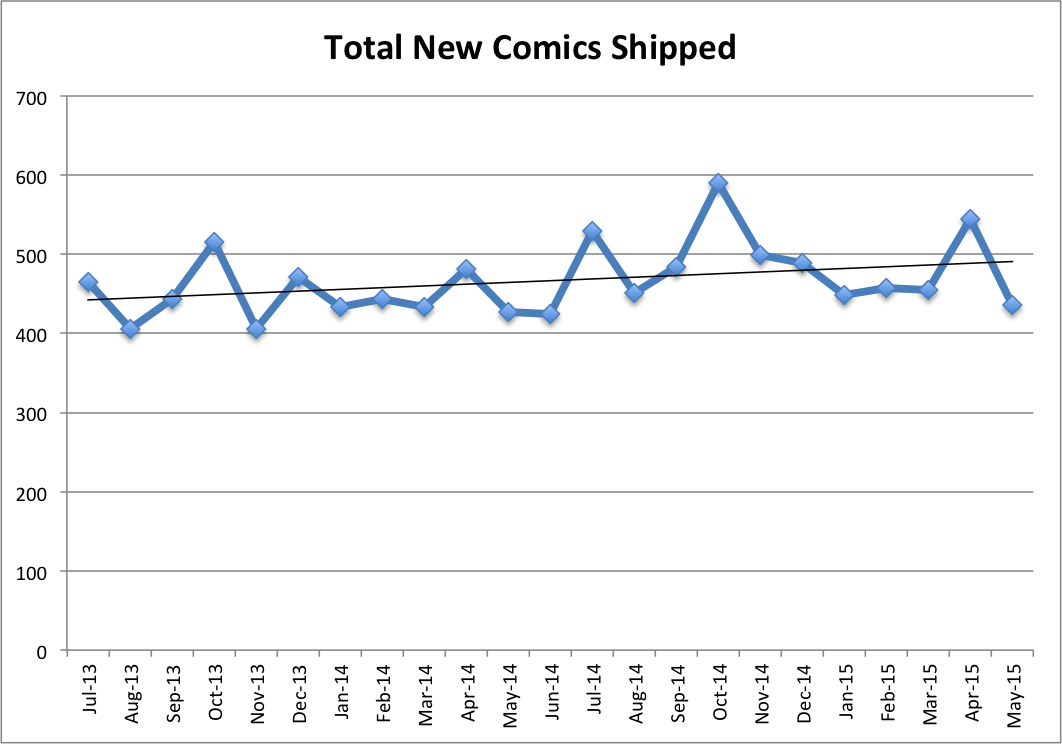
As you can see, things are trending up. April 2015 was another enormous month with 545 new comics, fueled by DC’s Convergence and Marvel’s Secret Wars tie-ins. While May 2015 was lower than July 2013, new monthly releases have arced upwards since that first date, peaking in the aforementioned windfall that was October 2014. If you attempt to normalize it and trend things using a 6-month rolling average, the picture gets even more vivid.
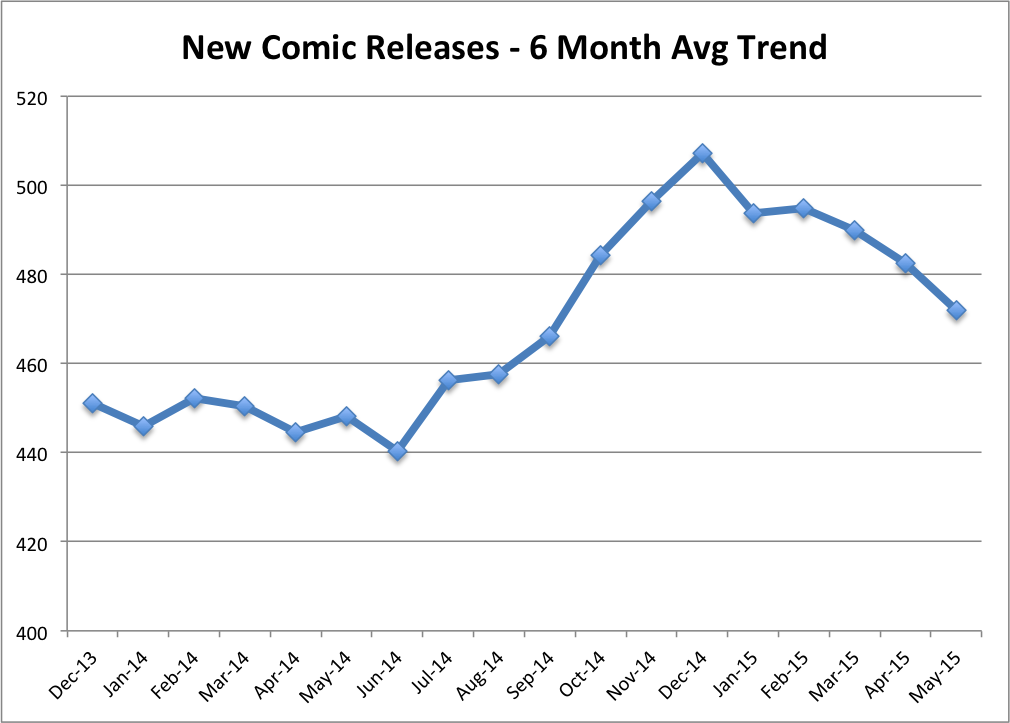
That’s a serious rise, and while it has tapered off, the first quarter of the year is the slowest time for both comics released and sold. That the last few months of data is still higher than December of 2013 despite being influenced by the first quarter is incredible, really. It doesn’t change much when you add trades and graphic novels to the mix as you see similar results across the board. The point is this: incredible amounts of comics are released every month, with no real signs of things slowing down, especially with Marvel’s “All-New, All-Different” endeavor coming in September.
But if things are growing so fast, who is generating that growth? Is one company more responsible for it than the others? To figure that out, I mapped out the total comics and graphic novels shipped since July 2013 for four publishers:
1. Marvel: the top seller
2. DC: their biggest rival
3. Image: the fastest growing publisher
4. Boom!: arguably the second fastest growing one
You can see the results below.
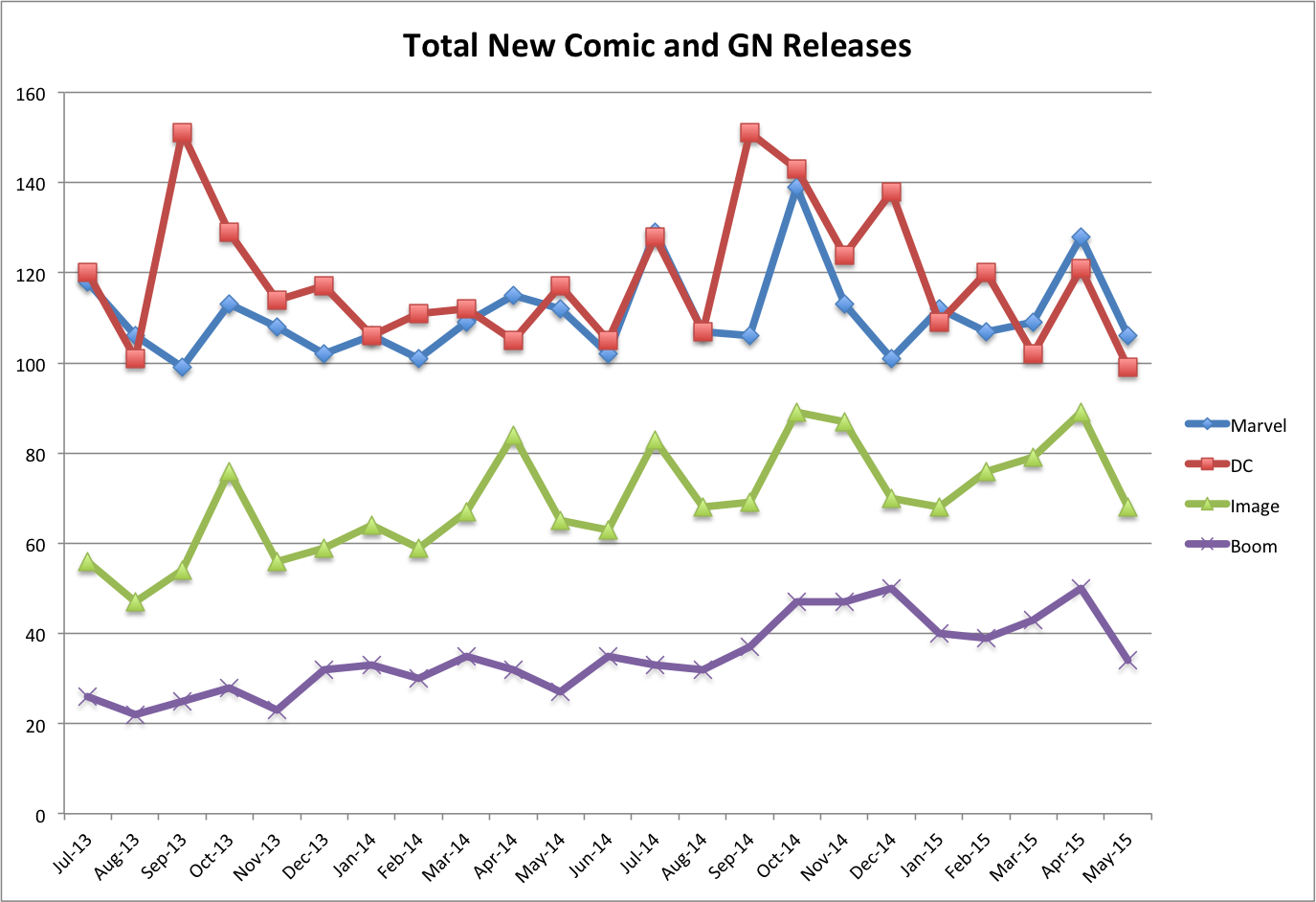
DC and Marvel on average release the most. When you average them out, they’re similar – 119 and 111 per month, respectively – but how they get there is befitting of the public perception of the two companies. DC has been all over the place, with its chart resembling the pulse of a person watching a horror movie. Marvel? Pretty even, all things considered.
It’s hard to tell, but DC’s release list is on a downward arc, while Marvel is trending upwards. Image and Boom! are rocket ships, and in their own right are much larger parts of the growth by percentage. Boom! by itself leapt from 22 total releases in August of 2013 to 50 in April of 2015, more than doubling their total in a year and a half (although they did drop back down in May). So if you’ve thought there were a lot more Image and Boom! releases now than there had been in the past, you’re right. There are a lot more.
Releasing more comics isn’t necessarily a bad thing though. You can make a sound argument that much of the industry’s revenue growth has been because of the increased amount of releases. In the prism of the original question – are there too many comics being released now? – the question morphs into something else. Is the increasing amount of comics negatively impacting sales?
Well, Is It?
Yes.
No.
Sort of. Depends on what we’re talking about.
All of those answers are true to a degree. But the last one is the most accurate. Let’s start with the first answer as that’s happy and happy is good.
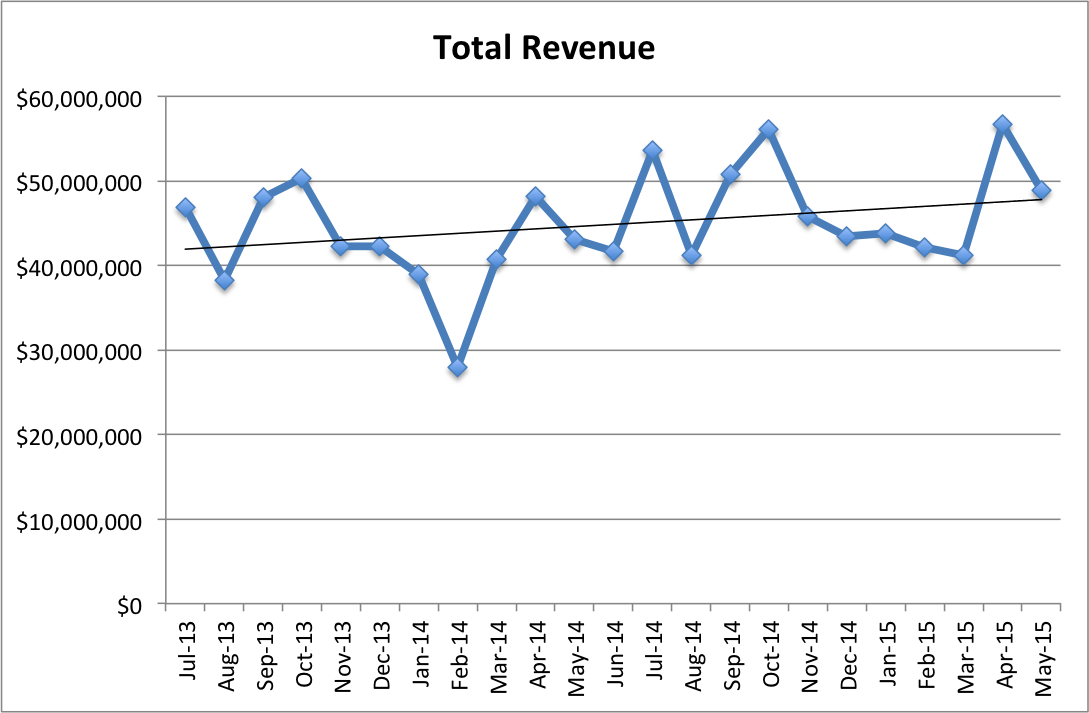
Comic revenues have been trending up, which is confirmed in graphical form above. More releases has meant more revenue, which means more articles on how things are looking up in comics. That’s always good, especially for me. In fact, if you ignore the terrible February 2014 revenue number, the comic industry has established a floor of around $40 million in monthly revenue. That’s a healthy number, and as a whole, it’s a number that is trending upwards.
Let’s dig into that second answer now.
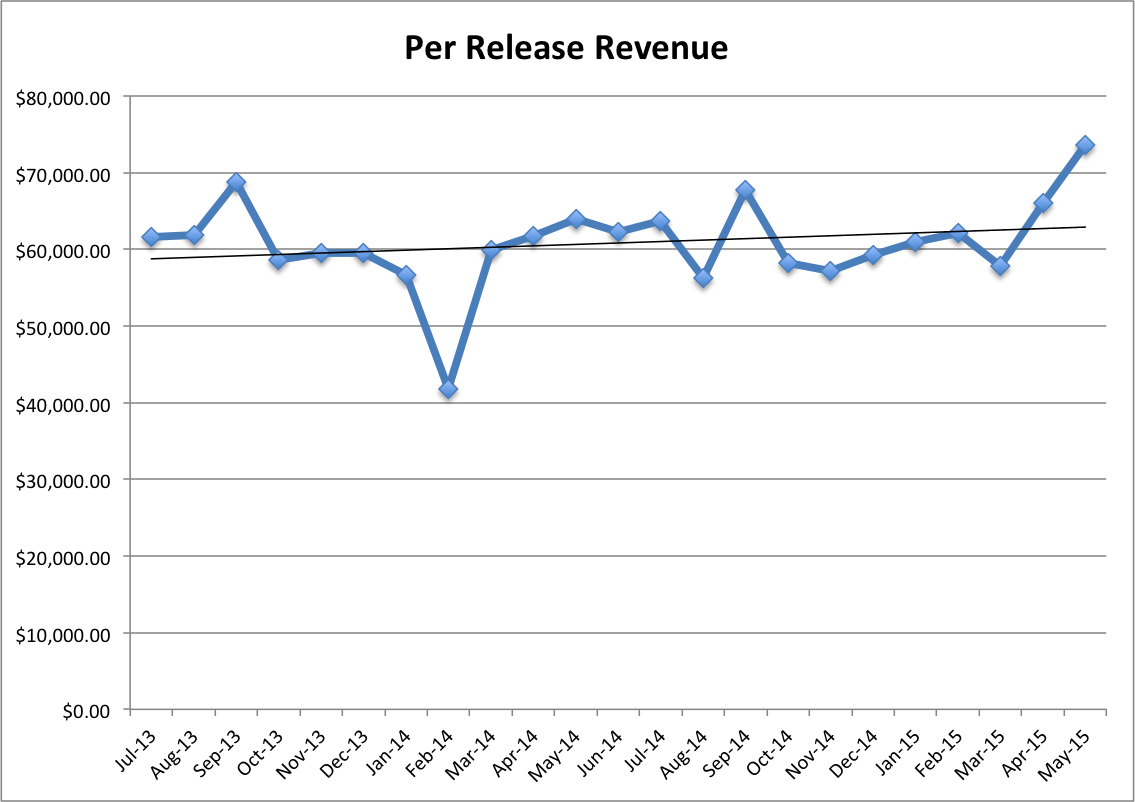
When you look at the revenue numbers on a per release basis – for comics, trades and graphic novels combined – that’s where things flatten out, but not as much as they had when I first researched this piece. While revenue is trending up, revenue on a per release basis is only arcing up slightly. That’s an incremental increase driven almost entirely by April and May’s Convergence and Secret Wars stimulated sales bonanza. If you removed the last two event driven months, this metric is dropping, but a funny thing happened on the way to Battleworld: May saw enormous numbers despite the fewest total releases since August of 2013. It was just a huge month at the top.
All things considered, though, things have stayed level despite a much more dramatic uptick in volume of releases. What we can say is that when faced with such a towering amount of releases, retailers cannot buy big on everything, which is understandable. They’re betting big on the certain sellers—Star Wars, Secret Wars, Convergence—and it’s working to the advantage of comic publishers.
But again, not every publisher is created equal. With both an expanding market and monthly release list, it’s to be expected that this will impact every publisher in different ways. To examine the impact it has had on specific publishers, let’s bring the foursome we looked at earlier – Marvel, DC, Image and Boom! – and see how they’re performing on a per release basis.
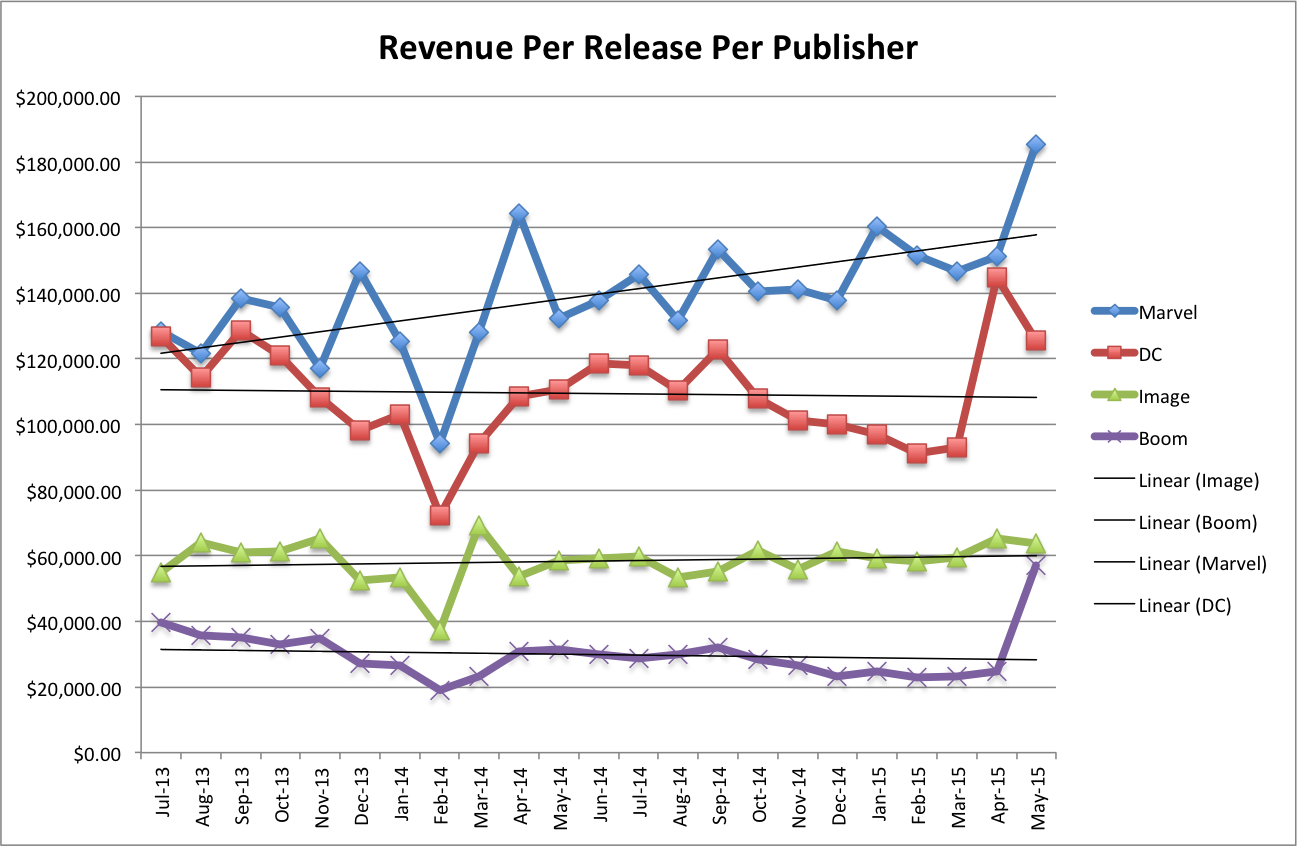
DC may release more total comics and graphic novels than everyone, but they’re typically—meaning not during event months—closer to Image on a revenue per release basis than they are Marvel. We will break down DC’s story at greater length in an article later today, but their trend – despite the occasional flare up – is one of a downward slope.
Conversely, Marvel is—to quote Dustin Pedroia—a laser show. The House of Ideas has seen consistent, significant growth, going from over $128,000 earned per release to over $185,000 in the past year and a half. They’re releasing more, but they’re making more per release, and at a rate that is outdistancing the rising cost of comics per issue. You can’t pin their increased success on $4.99 or $3.99 titles.
Ignoring May’s Loot Crate driven month, Boom! has seen a substantial, consistent drop in revenue per release, but I will give them a get out of jail free card. It’s one thing for DC to fall off when they have such a dedicated market presence. For a younger publisher that is releasing more and more titles while looking to gain support from both its readership and comic retailers, it’s more understandable they’d fall off. That said, nearly two years of decreases is a concern.
Image has incrementally trended upwards, which is impressive given the substantial growth of their line, but there’s an important element to note. Based off the data that Diamond reveals, Image appears to keep a lot more of aged trades and graphic novels in print and available for order than other publishers. That makes sense as Image titles are much more dependent on the trade market to develop its readership. But this also means they have books that are factored into the equation which decrease its per release revenue number in a punitive fashion.
To see if I was right in that theory, I looked at revenue per release strictly for new comics on Diamond’s Top 300 charts for those four publishers.
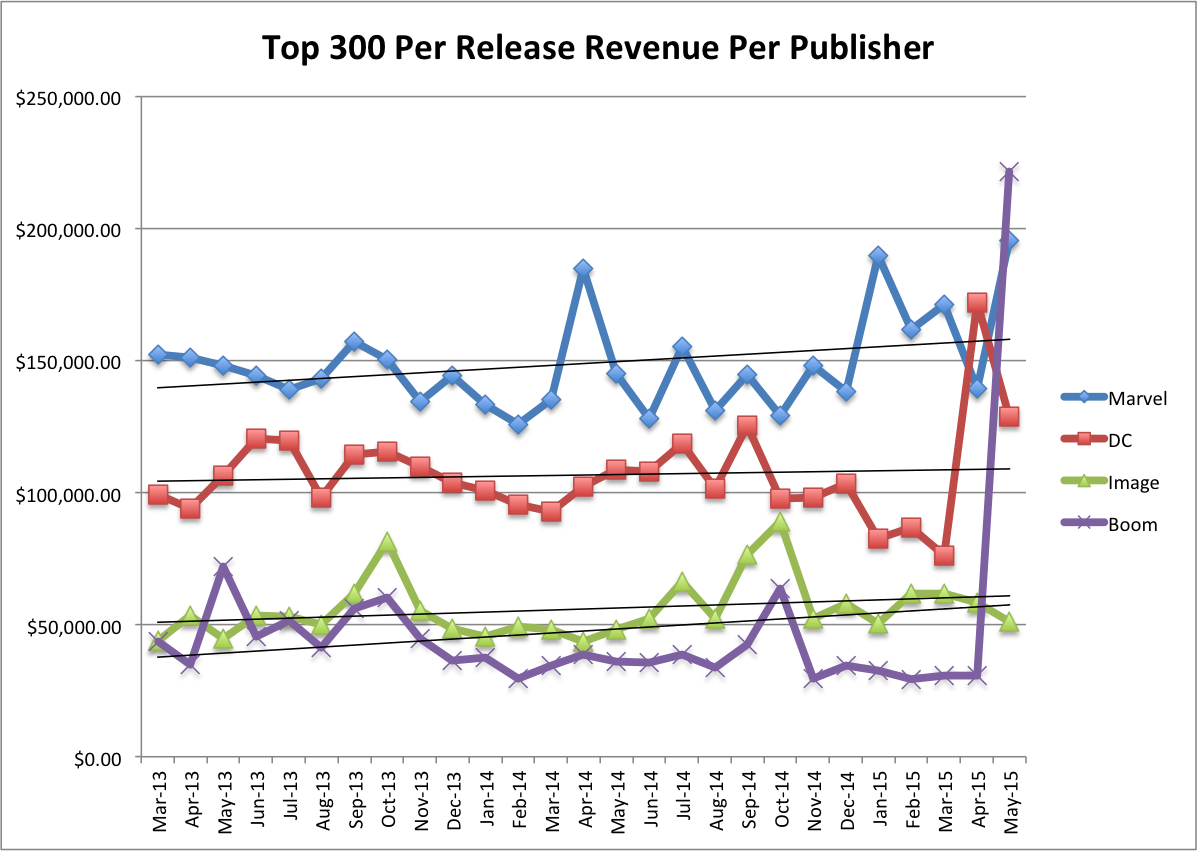
If that chart doesn’t explain the Loot Crate effect in one simple image, I don’t know what would. Boom!’s May stands out as an outlier, doesn’t it? It’s somewhat comedic how much the Loot Crate sales of Bravest Warriors: Tales from the Holo John #1 boosted their numbers. When you remove May from the equation, their numbers are in a consistent decline.
It’s the same story with DC as their last two months have been anomalies compared to their previous trend. That said, it is interesting how well they did despite releasing less comics in May than they had at any other time Diamond has tracked releases by publisher. Could less be more for them?
Image is what we’re here for though. Its revenue per release has skyrocketed, jumping up 32% from July of 2013 to April 2015; to the point Image is often $15 to $20,000 lower per release than DC. At this rate, they could surpass them soon in non-event months.
Ultimately, though, the answer to the original question—is the amount of releases negatively impacting sales?—is no. Sales are up, and the industry is sustaining the larger amount of titles available to them. It certainly depends on the publisher, as we’ve seen Marvel and Image drive an increasing percentage of the revenue. There has also been the effect of the lowest tiers of comics seeing increased sales as well. A rising tide lifts all ships, and that has been true in comics, with the #300 ranked title jumping over 242% between January of 2011 and January of 2015. Those are all very good things.
Is the Volume of Releases Negatively Impacting Quality?
This is the hard part if only because there isn’t quantifiable data to measure this. To figure it out, though, I’ll need a date in time to compare to. There’s one very obvious date to choose: September 2011. That was the month DC Comics launched its New 52 initiative, which jumpstarted all the growth we’ve seen over the past few years.
So has the quality changed since then? If you’re asking me, then the answer is “for the better”. Just think of the comics that have we have had since then. You’ve got monthlies like Saga, Hawkeye, Sex Criminals, Bitch Planet, Deadly Class and Lazarus as well as graphic novels like The Wrenchies, Beautiful Darkness, Boxers & Saints and This One Summer, and that’s just what I came up with on the spot. In 2015 we have an embarrassment of riches in comics, especially when you look at the diversity that comes with it. That’s both in terms of those creating the books and the kinds of books they’re making.
For monthlies in specific – as that is the main point of emphasis – a big part of that has to do with the boom of Image and the creator-owned movement. While those were around before, it feels like things have been taken to the next level in the past few years and that Warren Ellis was right on in his idea that more comics would beget more good comics. While I’m not sure this is the “Golden Age of Comics” as many have posited, what I will say is it is a very good one. More books of a discernible quality are being released than ever, and they are for more types of people. The volume is working in favor of the readers, not against them.
But don’t just take my word for it. Let’s hear from some other kind folks on the subject as I asked several industry pundits for their take on whether the overall quality of comics has shifted since the New 52 launch.
Heidi MacDonald, Editor-in-Chief of The Beat:
“(In my humble opinion), I think the comics industry in general is better than it was. I don’t think the New 52 is any better or DC is really any better, but bear in mind I don’t actually read DC comics. However the New 52 was a huge marketing success and brought a lot of new energy to the industry and sales are better now, a rising tide lifts all boats and that kind of thing. All the comics’ media has helped as well. Basically, readers came for the New 52 but stayed for Adventure Time and eventually Lumberjanes.
If you look outside the Big Two and even the rest of the Diamond exclusive, there are more, better comics being done industry wide than ever. And Image is putting out some great stuff as well.
Did the Ultimate line improve comics? Did 52 and other weekly comics? I don’t know for sure — maybe its just zeitgeist. But this is a golden age for sure.”
Brian Salvatore, Editor of Multiversity Comics:
“I think that quality of comics has stayed more or less the same, but that we’ve seen more changes around the margins. There have always been good and bad books, but I feel like the resources that publishers are putting into comics has meant that there are less of both, and more of the middle of the road comics. Part of this could also be that the standards have changed; what once looked great now looks ‘normal,’ so it is hard to tell if our standards have gotten higher, or if the product has just evened out.
I also think our attention span has shrunk considerably. It used to be that a new series had serious hype for the first arc or so; now, a book that came out last week is old news – in fact, sometimes, it is old news by the release date. Part of this is due to the constant reboot nature of comics, that we’ve seen more ‘Uncanny X-Men’ #1s in the past half decade than we had in the prior 50 years. But it is also because there are just so many comics being published, and even though we call them the ‘Big 2,’ there are easily 5 or 6 publishers that demand attention for new series.
Of course, the time frame you mention is also when the comics internet became more of a thing, and Twitter got more ubiquitous, and so you no longer just heard about a great (or terrible) new book from a friend or your local comics clerk, but from literally thousands of voices.
So, to answer your question, maybe?”
Dave Scheidt, Writer of Spooky Sleepover! and Adventure Time, Comic Fan, Raconteur:
“Comics have gotten much better in the past few years, I think. The creator owned stuff has been thriving and that’s bringing out the best in the people making those books. People are getting to tell the stories they want to tell and drawing the things they want to draw and people are buying those books. How cool is that? Comics are and have always been such pure and unfiltered storytelling and creator owned stuff is the best thing to happen to comics maybe ever.”
Two out of three were proponents of the idea that comics are better now than they were before the New 52, with the third on the fence about it. Majority rules: comics are better now with more comics being released.
So Are There Too Many Comics?
Let’s check our work.
– There are more comics and graphic novels being released now than any other time in the modern era, and more monthly comics than any time since 1993
– Comic revenues are up, and the leap in total releases hasn’t impacted per release revenues
– Comics are generally considered to be a better place, quality wise, then they have been in the past
That gives us a clear answer: there are not too many comics, at least not yet. I’m not saying we can’t get there eventually—and we may be approaching the tipping point where the volume of comics begin to impact sales—but overall, things continue to arc upwards into infinity.
It depends on whom you ask of course. If you’re asking the typical people who show up on comic site comment threads, then yeah, they’ll probably say there are too many comics. But I imagine the people who comment on a comic site are the long-term fans who are completionists, and the strain of trying to buy everything that stars your favorite character or is created by your favorite writer or artist is greater than ever for those folks. I can sympathize.
But for readers who don’t have those proclivities or the newer readers who are just looking for something for them? More comics is a very good thing. More comics means more diversity of creative teams, genre and format. That means it’s more likely now than ever that no matter what you look like or who you are, you can find something of interest to you in a comic shop. And odds are, it will be good, too.
For me, “too many comics” is a red herring in of itself. There can be too many bad comics. There can be too many comics for one specific audience. There can be too many comics of one specific genre. But too many when it means more good comics and more comics that people are excited about?
There’s no such thing.
All numbers are based off of Comichron data and calculations created on my own. They are not based off of true, final sales numbers, but estimates. However, the baseline is accurate and at least provides insight into the direction of the industry. Also worth noting, these numbers are orders from retailers from Diamond for comic products, not sales to readers such as myself. That data doesn’t exist, sadly.
